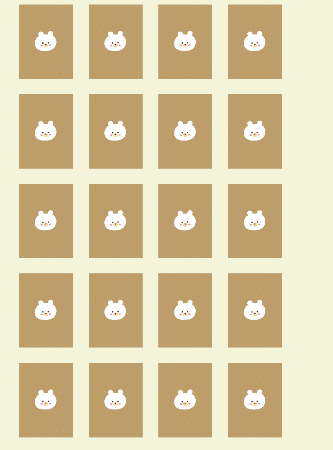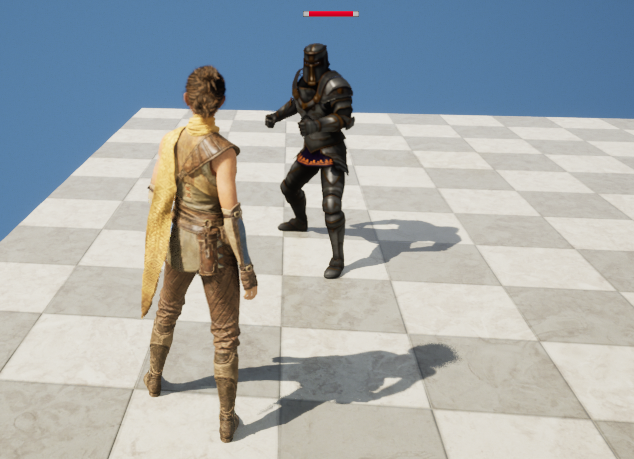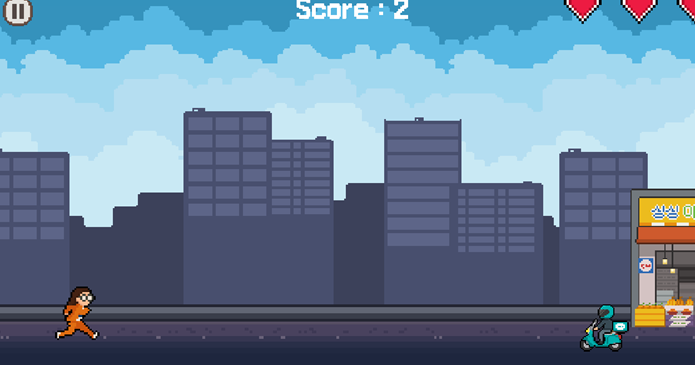https://www.youtube.com/watch?v=XhfB3ZS3JoM&list=LL&index=5&t=11139s
이번에 유투브 강의영상을 보고 따라 만들어 보기로 하였다. 여기서 똑같이 만드는 것이 아닌 내 방식대로 만들어보려고 한다.
그리고 여기에 내가 응원하는 배우님이 카페에 올려주신 사진을 활용해서 카드 짝 맞추기 게임을 만들어 볼 것이다.
구현 순서는 영상에 나오는 순서대로 구현을 해보도록 할 것이다.
1.카드 및 보드 구현
우선 카드 객체를 구현해보자 필요한 기능은 뒤집는 기능이 필요하다. 이 기능은 Dotween과 IPointerClickHandler를 사용하여 구현하였다.
Card.cs
using UnityEngine;
using UnityEngine.EventSystems;
using DG.Tweening;
public class Card : MonoBehaviour, IPointerClickHandler
{
[SerializeField] private SpriteRenderer spriteRenderer;
[SerializeField] private Sprite frontSprite;
[SerializeField] private Sprite backSprite;
private Board board;
private bool isFlipped = false;
private bool isAnimating = false;
private void Awake()
{
spriteRenderer = GetComponent<SpriteRenderer>();
}
public void SetCard(Sprite sprite, Board board)
{
frontSprite = sprite;
this.board = board;
backSprite = Resources.Load<Sprite>("Sprites/Front/Front"); // 뒷면 기본 이미지
spriteRenderer.sprite = backSprite;
}
public void OnPointerClick(PointerEventData eventData)
{
if (board.GetSelectedCardCount() >= 2 || isFlipped || isAnimating)
return; // 이미 2장이 선택되었으면 클릭 방지
FlipCard();
board.SelectCard(this);
}
public void FlipCard()
{
if (isAnimating) return;
isAnimating = true;
Vector3 targetScale = new Vector3(0f, transform.localScale.y, transform.localScale.z);
transform.DOScale(targetScale, 0.2f).OnComplete(() =>
{
spriteRenderer.sprite = isFlipped ? backSprite : frontSprite;
isFlipped = !isFlipped;
transform.DOScale(Vector3.one, 0.2f).OnComplete(() =>
{
isAnimating = false;
});
});
}
public void FlipBack()
{
if (!isFlipped) return;
FlipCard();
}
public Sprite GetSprite()
{
return frontSprite;
}
public bool IsFlipped()
{
return isFlipped;
}
}
보드는 모든 카드의 위치를 관리해주고 룰을 결정해준다. 카드는 4*5배열로 배치되게 하였다.
Board.cs
using UnityEngine;
using System.Collections.Generic;
using System.Linq;
public class Board : MonoBehaviour
{
[SerializeField] private GameObject cardPrefab;
[SerializeField] private Sprite[] cardSprites; // 카드 앞면 (1~6번 이미지)
private List<Card> cards = new List<Card>();
private List<Card> selectedCards = new List<Card>(); // 선택된 카드들
private int rowCount = 5; //세로
private int colCount = 4; //가로
private float xStart = -2.1f;
private float yStart = 3.3f;
private float xSpacing = 1.4f;
private float ySpacing = -1.8f;
private void Awake()
{
cardPrefab = Resources.Load<GameObject>("Prefabs/Card/Card");
LoadSprites();
ShuffleCards();
InitBoard();
}
void LoadSprites()
{
// Resources 폴더에서 "Sprites/0~9" 로드
cardSprites = new Sprite[10];
for (int i = 0; i < 10; i++)
{
cardSprites[i] = Resources.Load<Sprite>($"Sprites/Back/{i}");
}
}
public void ShuffleCards()
{
List<Sprite> tempSprites = new List<Sprite>();
// 0~9번 카드 각각 2장씩 추가
foreach (var sprite in cardSprites)
{
tempSprites.Add(sprite);
tempSprites.Add(sprite);
}
// 랜덤 섞기
tempSprites = tempSprites.OrderBy(x => Random.value).ToList();
// cards 리스트에 카드 추가
cards.Clear();
for (int i = 0; i < tempSprites.Count; i++)
{
GameObject newCard = Instantiate(cardPrefab, Vector3.zero, Quaternion.identity, this.transform);
Card card = newCard.GetComponent<Card>();
card.SetCard(tempSprites[i], this);
cards.Add(card);
}
}
public void InitBoard()
{
int index = 0;
for (int i = 0; i < rowCount; i++)
{
for (int j = 0; j < colCount; j++)
{
if (index >= cards.Count) return; // 카드 개수 초과 방지
// 위치 설정
Vector3 pos = new Vector3(xStart + (xSpacing * j), yStart + (ySpacing * i), 0);
// 기존에 생성된 카드 객체를 위치만 변경
cards[index++].transform.position = pos;
}
}
}
public void SelectCard(Card card)
{
if (selectedCards.Contains(card) || selectedCards.Count >= 2)
return;
selectedCards.Add(card);
if (selectedCards.Count == 2)
{
CheckMatch();
}
}
void CheckMatch()
{
if (selectedCards.Count < 2) return; // 두 장 선택되지 않으면 비교 불가
if (selectedCards[0].GetSprite() == selectedCards[1].GetSprite())
{
// 같은 카드라면 유지
selectedCards.Clear();
Managers.Audio.PlaySound("Match"); // 카드 맞추면 효과음 재생!
}
else
{
// 다른 카드라면 1초 후 다시 뒤집기
Invoke(nameof(ResetCards), 1f);
}
}
void ResetCards()
{
foreach (var card in selectedCards)
{
card.FlipBack();
}
selectedCards.Clear();
}
public int GetSelectedCardCount() => selectedCards.Count;
public List<Card> GetCards() => cards;
}
실제로 배치된 모습을 보면 다음과 같다

이제 GameManager를 통해 이 보드의 초기화 함수인 Init을 호출해주고 코루틴 함수를 통해 모든 카드를 오픈하고 다시 뒤집어서 유저가 게임을 진행할 수 있게 한다. 또한 시간을 관리해주고 게임이 이겼는지 확인해준다.
GamaManager.cs
using System;
using System.Collections;
using System.Collections.Generic;
using TMPro;
using UnityEngine;
using UnityEngine.PlayerLoop;
using UnityEngine.UI;
using static UnityEngine.RuleTile.TilingRuleOutput;
public class GameManager
{
private Board board;
private List<Card> cards;
private bool isGameActive = false;
private float gameTime = 60f; // 총 게임 시간
private float remainingTime; // 현재 남은 시간
private Slider timeSlider;
private Image sliderFill; // 슬라이더의 Fill 색상 변경용
private TextMeshProUGUI timeText; // 남은 시간을 표시하는 UI
public event Action<float> OnTimeUpdated;
public void Init()
{
board = GameObject.Find("Board")?.GetComponent<Board>();
timeSlider = GameObject.Find("TimeOutSlider")?.GetComponent<Slider>();
timeText = GameObject.Find("TimeOutText")?.GetComponent<TextMeshProUGUI>();
if (board == null || timeSlider == null || timeText == null)
{
Debug.LogError("GameManager 초기화 실패 - 필수 UI 요소가 없음.");
return;
}
// 게임 시작
isGameActive = true;
sliderFill = timeSlider.fillRect.GetComponent<Image>();
remainingTime = gameTime;
CoroutineHelper.StartCoroutine(StartGameSequence());
}
IEnumerator StartGameSequence()
{
// 보드가 초기화될 시간을 기다림
yield return new WaitForSeconds(0.3f);
cards = board.GetCards();
// 모든 카드 공개 (처음 1초 동안)
foreach (var card in cards)
{
card.FlipCard();
}
yield return new WaitForSeconds(1.5f);
// 다시 뒤집기
foreach (var card in cards)
{
card.FlipBack();
}
yield return new WaitForSeconds(0.3f);
// 타이머 UI 활성화
timeSlider.gameObject.SetActive(true);
timeText.gameObject.SetActive(true);
Managers.Audio.PlayBGM("BGM");
CoroutineHelper.StartCoroutine(UpdateTimer());
}
IEnumerator UpdateTimer()
{
while (remainingTime > 0 && isGameActive)
{
remainingTime -= Time.deltaTime;
timeSlider.value = remainingTime;
OnTimeUpdated?.Invoke(remainingTime); // UI 업데이트 호출
if (CheckWinCondition())
{
GameOver(true);
yield return new WaitForSeconds(1f);
yield break;
}
yield return null;
}
if (remainingTime <= 0)
{
GameOver(false);
}
}
private bool CheckWinCondition()
{
foreach (var card in board.GetCards())
{
if (!card.IsFlipped()) return false;
}
return true;
}
private void GameOver(bool isWin)
{
isGameActive = false;
Time.timeScale = 0.0f;
CoroutineHelper.StartCoroutine(GameOverSequence(isWin));
}
private IEnumerator GameOverSequence(bool isWin)
{
yield return new WaitForSecondsRealtime(0.5f); // 0.5초 딜레이 후 실행
// DOTween의 모든 트위닝을 제거
DG.Tweening.DOTween.KillAll();
if (isWin)
{
Managers.UI.ShowPopupUI<UI_Success>();
}
else
{
Managers.UI.ShowPopupUI<UI_GameOver>();
}
}
}
그리고 게임에 필요한 UI는 UI_Game으로 묶어서 관리해주도록 했다. 옵저버 패턴을 사용하여 시간이 지남에 따라 색깔이 바뀌고 슬라이더의 바가 줄어들도록 구현했다. 이때 각 오브젝트의 이름과 Bind하는 enum 변수들의 이름이 같아야 정상적으로 Bind가 이루어진다.
UI_Game.cs
using System.Collections;
using System.Collections.Generic;
using TMPro;
using UnityEngine;
using UnityEngine.EventSystems;
using UnityEngine.UI;
public class UI_Game : UI_Scene
{
enum Buttons
{
EscapeButton,
}
enum Texts
{
TimeOutText,
}
enum GameObjects
{
TimeOutSlider,
}
private float gameTime = 60f; // 총 게임 시간
public override void Init()
{
base.Init(); // 상위 클래스의 초기화 메서드 호출
Bind<Button>(typeof(Buttons));
Bind<TextMeshProUGUI>(typeof(Texts));
Bind<GameObject>(typeof(GameObjects));
GetObject((int)GameObjects.TimeOutSlider).GetComponent<Slider>().maxValue = gameTime;
GetObject((int)GameObjects.TimeOutSlider).GetComponent<Slider>().value = gameTime;
GetButton((int)Buttons.EscapeButton).gameObject.AddUIEvent(PauseOrResume);
Managers.Game.OnTimeUpdated += UpdateTimeUI;
}
void PauseOrResume(PointerEventData eventData)
{
// 1. 뭐든지 열려있으면 다 닫기
// 2. 아무것도 없으면 열기
if (Managers.UI.GetStackSize() > 0)
Managers.UI.CloseAllPopupUI();
else
Managers.UI.ShowPopupUI<UI_PausePopup>();
}
private void UpdateTimeUI(float time)
{
GetText((int)Texts.TimeOutText).text = Mathf.CeilToInt(time).ToString();
GetObject((int)GameObjects.TimeOutSlider).GetComponent<Slider>().value = time;
UpdateTimeColor(time);
}
private void UpdateTimeColor(float time)
{
float normalizedTime = time / gameTime;
Color startColor = new Color(0.96f, 0.55f, 0.0f);
Color endColor = new Color(1.0f, 0.0f, 0.0f);
Color timeColor = Color.Lerp(endColor, startColor, normalizedTime);
GetText((int)Texts.TimeOutText).color = timeColor;
GetObject((int)GameObjects.TimeOutSlider).GetComponent<Slider>().fillRect.GetComponent<Image>().color = timeColor;
}
private void OnDisable()
{
Managers.Game.OnTimeUpdated -= UpdateTimeUI;
}
}
UI구성은 다음과 같다.

'게임공부 > Unity' 카테고리의 다른 글
| [Unity][C#][비행기 슈팅 게임]1. 움직이기(new Input system) (0) | 2025.03.13 |
|---|---|
| [C#][Unity][나만의 탑뷰 게임 만들기]9. 적 시스템구현1(FSM) (0) | 2025.01.30 |
| [C#][Unity][나만의 탑뷰 게임 만들기]8. 인벤토리 시스템 수정 (1) | 2025.01.13 |
| [C#][디자인 패턴]State 패턴 (0) | 2025.01.09 |
| [Unity]최적화 관련 팁 (0) | 2025.01.08 |

























































































